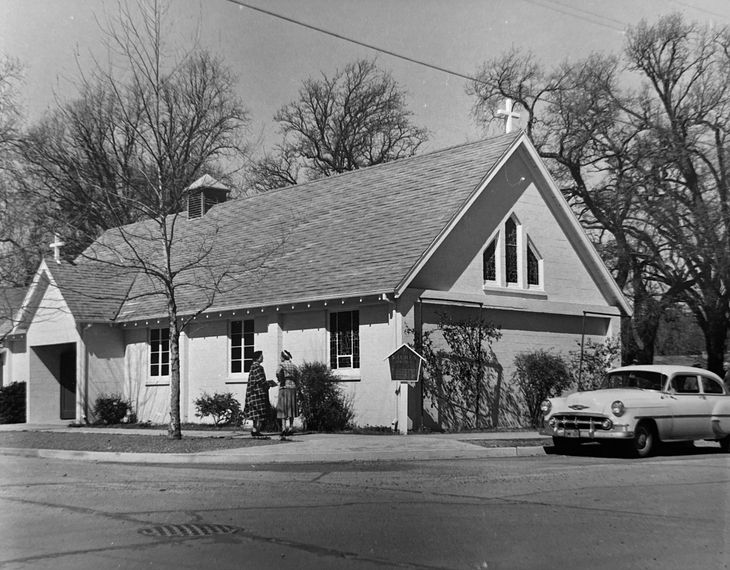
St. Luke's is a small, charming chapel with a rich history dating back to its establishment in 1917. Nestled in the picturesque town of Calistoga, it offers a serene and quaint setting for visitors and worshippers alike.
As Episcopalians we believe in a loving, liberating and life-giving God: Father, Son and Holy Spirit. As constituent members of the Anglican Communion in the United States, we are descendants of and partners with the Church of England and the Scottish Episcopal Church and are part of the third largest group of Christians in the world.
We believe in following the teachings of Jesus Christ, whose life, death and resurrection saved the world.
We have a legacy of inclusion, aspiring to tell and exemplify God's love for every human being; women and men serve as bishops, priests and deacons in our church. Laypeople and clergy cooperate as leaders at all levels of our church. Leadership is a gift from God, and can be expressed by all people in our church, regardless of sexual identity or orientation.
We believe that God loves you -- no exceptions.
History of St. Luke’s Episcopal Church, Calistoga

Easter Sunday, April 17, 2022: the congregation of St. Luke’s Episcopal Church in Calistoga celebrated the 75thanniversary of the building of its church at the corner of Myrtle and Berry streets. The congregation, though, is much older than that.
June 1917: first recorded Episcopal service with the Rev. R. L. MacFarlane of Healdsburg officiating.
Feb. 23, 1918: St. Luke’s Episcopal Church organized in the old Calistoga hotel building with the Rt. Rev. William Hall Moreland, Bishop of the Diocese of Sacramento in attendance. With a handful of people pledging $30 per month (about $574 today), the Bishop established St. Luke’s Mission. Officers were Albert L. Hawke, Warden (who would serve as warden for 40 years); Mrs. Harry (Grace) vonArx, secretary and Mrs. E. I. Sielcken, treasurer.
1923: worship services held every Sunday, alternating between Holy Communion and Morning Prayer.
1924: building fund established with a balance of $24.50.
1928: lot on Myrtle Street bought for $500 for the purpose of building a church.
1929: adjoining lot bought for $500.
1930s-1950s: St. Luke’s Guild (later the Episcopal Church Women) raised money to build the church and Memorial Hall with monthly food sales, an annual bazaar and October Harvest Dinner. Two pillars of the church, Telka Mitchell and Virginia Harmon spent years raising money by selling Aycock stainless steel flatware at county fairs throughout Northern California and the Western United States. One year, the two women sold the flatware at 13 fairs, including one in Phoenix, Ariz.
Late 1946: the foundation is laid for the new basalite block church, measuring 28-feet by 38-feet and construction begins. On the building committee were Ed Wuest, chairman, Albert L. Hawke, Thekla S. Mitchell and Clarence Bowell. Volunteer workers were Herbert Washburn, Andrew Tahja, Jack Taylor and Lew Mitchell, who supervised the construction.
April 1947: the church was completed, costing $13,000. All the bills were paid.
April 26, 1947: the first service of Holy Eucharist was held in the new building, with the Rev. P. Malcolm Stewart presiding.
Jan. 30, 1949: Bishop Archie W. Noel Porter formally consecrated the church.
1954-55: through the efforts of the Episcopal Church Women and other gifts, a Memorial Hall and kitchen were built. Cost was $15,000.
January 1955: Canon C. Aaron King was St. Luke’s first full-time priest.
1962: a gift paid for the purchase of the vicarage house at 1715 Adele St., Calistoga.
Mid-1960s: a gift from the Ben Sharpsteen family and a capital funds drive paid for church volunteers to build an office, meeting room and sacristy.
November 1968: the Rev. Wallace E. Sprague undertook the redesign of the interior of the church, which included the addition of a six-foot, hand carved Christus Rex, (Christ as the high priest), placed under the St. Luke window above the altar.
1968: hand-crafted stained glass windows, given as memorials to loved ones, have replaced all 11 amber-glass windows in the nave and sanctuary.
Oct. 20, 1974: marked the completion and blessing of the Albert L. Hawke Prayer Garden, adjoining the church.
May 6, 2004: St. Luke’s Preschool, later Hearts and Hands Preschool, opens in the parish hall, after $100,000 borrowed for improvements, both inside and outside. Much of the money borrowed from parishioners was later forgiven.
January 2019: After the retirement of Diocesan Bishop Berry Leigh Beisner, the five candidates for bishop of the Episcopal Diocese of Northern California paid a visit to St. Luke’s and stopped for lunch on their bus tour of the diocese. The Rev. Canon Megan M. Traquair was elected the eighth bishop at an election convention, held at Faith Episcopal Church in Cameron Park.
March 2020: a worldwide pandemic, COVID-19, forced the closure of offices, stores and churches, including St. Luke’s Episcopal Church. Shortly thereafter, St. Luke’s began to offer Sunday video services online via Zoom and later from the sanctuary with just the Rev. William “Father Mac” McIlmoyl and videographer Nathan Schwab present. Later as vaccinations became widely available, church leaders opened the sanctuary to the congregation, while still offering video Zoom services to those who wished to remain at home. More than two years later, the services continue to be shown live and recorded on social media outlets.
May 2022: the church’s Mission Committee, under the guidance of Senior Warden Carolyn Czapleski and Junior Warden Connie Schellenger, completed the renovation of the vicarage house at 1715 Adele St., after a fundraising campaign. Cost was roughly $80,000 and the work was completed in five months, from January to May 2022.
Compiled by David Stoneberg. Information from four histories of St. Luke’s Episcopal Church: “Come Together … and Rejoice!”; “A History of St. Luke’s Episcopal Church,” compiled by Lois Carroll Winston, 1975; “A house unto the Lord,” by Betty Dopson, 1997; and the “60th Anniversary History of St. Luke’s” compiled in 2009.
